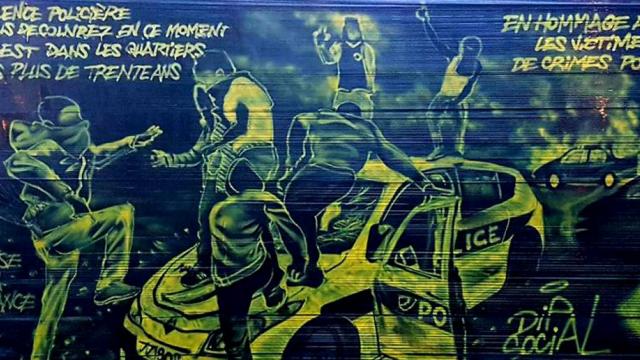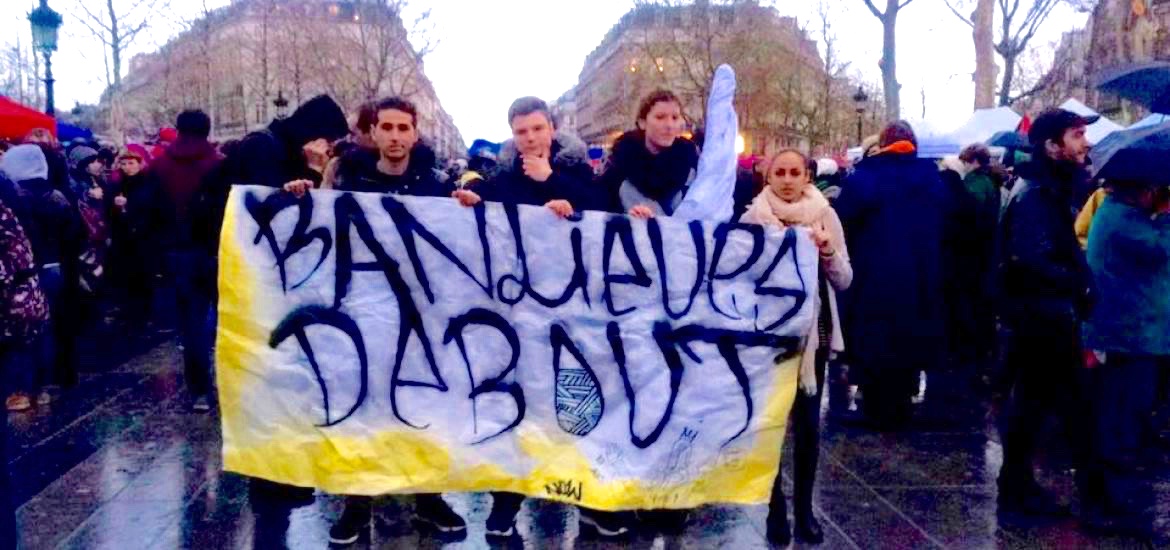
The banlieues, suburbs existing beyond the Périphérique on the outskirts of Paris, are part of a complex socioeconomic and cultural world which is seldom viewed outside the context of its issues and problems. It is a place only its working class residents truly know, and their stories often do not mirror the scenes in La Haine.
With his 1960 black and white short film "L'Amour existe," referenced by Luc Sante in his book The Other Paris, Maurice Pialat introduced the banlieue not as the regressive dystopian zone it is frequently described as these days, but simply as a place to live and enjoy life. Voiced by Jean-Loup Reinhold, Pialat's own words about the banlieues highlight the indelible imprint these places made in his life: "My first memory is a memory of suburbs. On the borders of my memory, a suburban train passes, as in a film."
Now, we have a new interpretation of banlieues within the current cycle of global activism: Banlieues Debout.
David Cousy, a co-founder of Banlieues Debout, says the banlieues-centric movement is a spinoff of Nuit Debout Paris, but functions independently of the horizontal democracy-based movement from which it takes its name. Cousy says it takes him 40 minutes to ride the train from his Les Bleuets neighborhood in Créteil to Place de la République, which has functioned as the main site of the Nuit Debout Paris movement since March 31.
Cousy's commute is easier than it is for many banlieue residents. He says their longer commute can be exhausting in and of itself. "Yes, it sometimes creates a sense of despair for people that have to take a crowded train for an hour and a half to go to work and then have to take the same time to come back home, which implies that they cannot spend the time they want to or need to with their families and relatives and can feel like their life is only sleeping, riding the train, working and sleeping again," he notes.
Lately, in addition to the daily realities experienced by banlieue residents, there has been much focus on a case of police brutality involving a 24-year-old man named Adama Traoré, who died under questionable circumstances while in the custody of French police on July 19.
Quoi Ma Gueule, an organization that has focused on ethnic and racial profiling, as well as the controversial French paperless system – which does not produce citations or tickets, and which French President François Hollande promised to address before he was elected, but has failed to do so since – has spread awareness about police brutality in France by listing the names of people who have died at the hands of authorities, including Lamine Dieng (2007), Hakim Ajimi (2008), Ali Ziri (2009), Amadou Koumé (2015) and Traoré, whose latest autopsy declared he died of asphyxiation after an earlier autopsy attributed his death to infection and a heart problem.
"This kind of police brutality is maybe rare if we have to compare France with some other countries, but this is still too much and too often that it happens and most of the time, the citizens of the banlieues are the first victims of the abuses," says Cousy.
Several protests and memorial tributes have been held in Traoré's honor. In his letter to French prosecutor Yves Jannier, Dominique Sopo, the president of an anti-racism organization SOS Racisme, asked pointedly, "What is the chain of circumstances that led to the death of Adama Traoré? No one knows yet exactly but the issue of the responsibility of the police who effected his arrest is legitimately asked, whether you like it or not." More than 10 years ago, in 2005, the deaths of Bouna Traoré and Zyed Benna, who died after being chased by police, led to a massive rebellion in the banlieues.
Other issues of the suburbs addressed by Banlieues Debout center around the economic realities of many banlieue residents. High unemployment remains a problem in the banlieues, where many residents could be described as working class. There are also middle class residents and some wealthy residents. However, sometimes residents who live in the suburbs find themselves in precarious positions and emergency situations.
Just recently in Montreuil, the same banlieue where Georges Melies's old studio was demolished according to Pialat's "L'amour existe," a group of 13 Romani immigrant families were evicted from their homes and forced to live on sidewalks. "About the recent situation of the Romani families which were expelled and displaced from their homes recently which happened at 250 Boulevard de la Boissière in Montreuil, we wanted to show our solidarity with these citizens that are now homeless, with little children, and left alone in the streets," says Cousy.
In another case, a working woman was threatened with being evicted from her apartment because the apartment had a major infestation of bed bugs and she felt it was unfair to continue paying to live in a place dominated by insects. According to Cousy, who is also president of a community organization called Créteil 3.0, Banlieues Debout organized a march of 50 people to address the issue. He hopes the action will result in the woman and her family being moved into better living quarters.
Since his involvement in Nuit Debout Paris, Cousy determined that the banlieues would be a better place to address the pressing economic and social issues facing residents than Place de la République in Paris. The movement in Paris originally focused on the draconian Loi Travail, or Loi El Khomri, a new labor law passed by invoking the authoritarian 49-3 clause of the French Constitution. He disagreed with the "neocolonial" idea of Nuitdeboutistes who don't live in the banlieues attempting to organize on behalf of banlieue residents by creating a commission.
"That's why we launched Banlieues Debout, calling for an independent mobilization in the banlieues, and more than 40 cities answered that call and began to meet at their public places each week to organize free and public democratic debates about their future and the future of their cities and the residents of the banlieues," Cousy says.
Along the lines of making sure banlieue residents' voices are heard in their own neighborhoods and cities, Cousy offers another way of looking at residents that debunks what he feels are rampant misconceptions and stereotypes of people who live in the banlieues.
"What I like about people who live out there is that everyone is very proud of their 'banlieursarde' identity. They are really hard workers and very creative people in every field, not only in sports and rap music; they have a strong will to succeed," he says. Describing the suburbs as "a big concrete village where everybody knows each other" and which are also a lot less noisy than Paris, he adds: "Plus, you have really nice squares and parks in the suburbs, which means more nature and more places where you can go for a run or a walk. In a way, I think that life in the suburbs may be healthier than life inside of Paris."
For now, if Banlieues Debout can draw further attention to the economic conditions facing people in the suburbs, it will be a step toward building the movement power achieved last spring by urban protesters with Nuit Debout.
3 WAYS TO SHOW YOUR SUPPORT
- Log in to post comments












